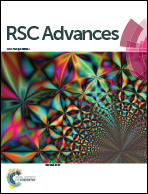Microwave-assisted route for the preparation of Pd anchored on surfactant functionalized ordered mesoporous carbon and its electrochemical applications
Abstract
A microwave-assisted route for rapidly synthesizing Pd nanoparticles assembled on sodium dodecyl sulphate (SDS)-functionalized ordered mesoporous carbon (Pd-SOMC) hybrid nanocomposites has been reported. The formation of the composite materials was verified by detailed characterization (e.g., energy-dispersive X-ray spectra, X-ray photoelectron spectroscopy, X-ray diffraction, electrochemical impedance spectroscopy and TEM). TEM images reveal that the Pd nanoparticles with an average size of ∼3.82 nm are uniformly dispersed on the surface of OMC. The novel nanohybrids of Pd-SOMC can provide new features of electro-catalytic activities, because of the synergetic effects of Pd nanoparticles and OMC materials. The successful fabrication of Pd-SOMC holds great promise for the design of electrochemical sensors, and is a promising way to promote the development of new electrode materials.


 Please wait while we load your content...
Please wait while we load your content...